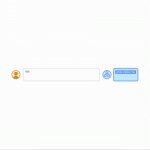Empowering end-users to interactively train robots to carry out novel duties is a vital functionality for his or her profitable integration into real-world purposes. For instance, a person might wish to train a robotic canine to carry out a brand new trick, or train a manipulator robotic the way to set up a lunch field primarily based on person preferences. The latest developments in large language models (LLMs) pre-trained on intensive web knowledge have proven a promising path in the direction of reaching this objective. Certainly, researchers have explored various methods of leveraging LLMs for robotics, from step-by-step planning and goal-oriented dialogue to robot-code-writing agents.
Whereas these strategies impart new modes of compositional generalization, they concentrate on utilizing language to hyperlink collectively new behaviors from an existing library of control primitives which can be both manually engineered or realized a priori. Regardless of having inside data about robotic motions, LLMs battle to straight output low-level robotic instructions because of the restricted availability of related coaching knowledge. In consequence, the expression of those strategies are bottlenecked by the breadth of the out there primitives, the design of which frequently requires intensive professional data or large knowledge assortment.
In “Language to Rewards for Robotic Skill Synthesis”, we suggest an strategy to allow customers to show robots novel actions via pure language enter. To take action, we leverage reward features as an interface that bridges the hole between language and low-level robotic actions. We posit that reward features present a really perfect interface for such duties given their richness in semantics, modularity, and interpretability. Additionally they present a direct connection to low-level insurance policies via black-box optimization or reinforcement studying (RL). We developed a language-to-reward system that leverages LLMs to translate pure language person directions into reward-specifying code after which applies MuJoCo MPC to search out optimum low-level robotic actions that maximize the generated reward perform. We display our language-to-reward system on quite a lot of robotic management duties in simulation utilizing a quadruped robotic and a dexterous manipulator robotic. We additional validate our methodology on a bodily robotic manipulator.
The language-to-reward system consists of two core parts: (1) a Reward Translator, and (2) a Movement Controller. The Reward Translator maps pure language instruction from customers to reward features represented as python code. The Movement Controller optimizes the given reward perform utilizing receding horizon optimization to search out the optimum low-level robotic actions, comparable to the quantity of torque that must be utilized to every robotic motor.
Reward Translator: Translating person directions to reward features
The Reward Translator module was constructed with the objective of mapping pure language person directions to reward features. Reward tuning is very domain-specific and requires professional data, so it was not shocking to us once we discovered that LLMs educated on generic language datasets are unable to straight generate a reward perform for a selected {hardware}. To deal with this, we apply the in-context learning skill of LLMs. Moreover, we break up the Reward Translator into two sub-modules: Movement Descriptor and Reward Coder.
Movement Descriptor
First, we design a Movement Descriptor that interprets enter from a person and expands it right into a pure language description of the specified robotic movement following a predefined template. This Movement Descriptor turns doubtlessly ambiguous or obscure person directions into extra particular and descriptive robotic motions, making the reward coding job extra steady. Furthermore, customers work together with the system via the movement description subject, so this additionally supplies a extra interpretable interface for customers in comparison with straight exhibiting the reward perform.
To create the Movement Descriptor, we use an LLM to translate the person enter into an in depth description of the specified robotic movement. We design prompts that information the LLMs to output the movement description with the correct quantity of particulars and format. By translating a obscure person instruction right into a extra detailed description, we’re in a position to extra reliably generate the reward perform with our system. This concept can be doubtlessly utilized extra usually past robotics duties, and is related to Inner-Monologue and chain-of-thought prompting.
Reward Coder
Within the second stage, we use the identical LLM from Movement Descriptor for Reward Coder, which interprets generated movement description into the reward perform. Reward features are represented utilizing python code to learn from the LLMs’ data of reward, coding, and code construction.
Ideally, we wish to use an LLM to straight generate a reward perform R (s, t) that maps the robotic state s and time t right into a scalar reward worth. Nonetheless, producing the proper reward perform from scratch remains to be a difficult drawback for LLMs and correcting the errors requires the person to know the generated code to offer the precise suggestions. As such, we pre-define a set of reward phrases which can be generally used for the robotic of curiosity and permit LLMs to composite completely different reward phrases to formulate the ultimate reward perform. To realize this, we design a prompt that specifies the reward phrases and information the LLM to generate the proper reward perform for the duty.
 |
| The interior construction of the Reward Translator, which is tasked to map person inputs to reward features. |
Movement Controller: Translating reward features to robotic actions
The Movement Controller takes the reward perform generated by the Reward Translator and synthesizes a controller that maps robotic commentary to low-level robotic actions. To do that, we formulate the controller synthesis drawback as a Markov decision process (MDP), which will be solved utilizing completely different methods, together with RL, offline trajectory optimization, or model predictive control (MPC). Particularly, we use an open-source implementation primarily based on the MuJoCo MPC (MJPC).
MJPC has demonstrated the interactive creation of various behaviors, comparable to legged locomotion, greedy, and finger-gaiting, whereas supporting a number of planning algorithms, comparable to iterative linear–quadratic–Gaussian (iLQG) and predictive sampling. Extra importantly, the frequent re-planning in MJPC empowers its robustness to uncertainties within the system and permits an interactive movement synthesis and correction system when mixed with LLMs.
Examples
Robotic canine
Within the first instance, we apply the language-to-reward system to a simulated quadruped robotic and train it to carry out varied expertise. For every ability, the person will present a concise instruction to the system, which is able to then synthesize the robotic movement through the use of reward features as an intermediate interface.
Dexterous manipulator
We then apply the language-to-reward system to a dexterous manipulator robotic to carry out quite a lot of manipulation duties. The dexterous manipulator has 27 levels of freedom, which could be very difficult to manage. Many of those duties require manipulation expertise past greedy, making it tough for pre-designed primitives to work. We additionally embody an instance the place the person can interactively instruct the robotic to put an apple inside a drawer.
Validation on actual robots
We additionally validate the language-to-reward methodology utilizing a real-world manipulation robotic to carry out duties comparable to selecting up objects and opening a drawer. To carry out the optimization in Movement Controller, we use AprilTag, a fiducial marker system, and F-VLM, an open-vocabulary object detection device, to determine the place of the desk and objects being manipulated.
Conclusion
On this work, we describe a brand new paradigm for interfacing an LLM with a robotic via reward features, powered by a low-level mannequin predictive management device, MuJoCo MPC. Utilizing reward features because the interface permits LLMs to work in a semantic-rich house that performs to the strengths of LLMs, whereas making certain the expressiveness of the ensuing controller. To additional enhance the efficiency of the system, we suggest to make use of a structured movement description template to raised extract inside data about robotic motions from LLMs. We display our proposed system on two simulated robotic platforms and one actual robotic for each locomotion and manipulation duties.
Acknowledgements
We wish to thank our co-authors Nimrod Gileadi, Chuyuan Fu, Sean Kirmani, Kuang-Huei Lee, Montse Gonzalez Arenas, Hao-Tien Lewis Chiang, Tom Erez, Leonard Hasenclever, Brian Ichter, Ted Xiao, Peng Xu, Andy Zeng, Tingnan Zhang, Nicolas Heess, Dorsa Sadigh, Jie Tan, and Yuval Tassa for his or her assist and assist in varied points of the undertaking. We’d additionally wish to acknowledge Ken Caluwaerts, Kristian Hartikainen, Steven Bohez, Carolina Parada, Marc Toussaint, and the groups at Google DeepMind for his or her suggestions and contributions.




